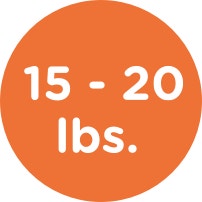HOW DO YOU KNOW IF YOUR CAT IS HEALTHY?
To help keep them independent and wonderfully uncooperative, remember to check your C.A.T.S.

SIGNS OF A HEALTHY SIZE OR WEIGHT

PADDING
When you hold your cat, you should be able to feel their ribs and a healthy little layer of padding (opens in new window) around them.

FIT
The padding around your cat should feel similar to what's on the back of your hand – a little elastic, but close to your cat's muscles.

FLUCTUATION
Just like their owners, your cat’s size may change a bit with age or as seasons change. A little variation is normal, as long as the changes aren’t rapid.
CHECKING YOUR C.A.T.S.?
Watch your cat’s pillow explain signs of a healthy size.
“Cats have what’s called a primordial pouch, but there should still be some differentiation between their chest and waist.”
YOUR CAT’S SIZE IS UNIQUE
Depending on their breed, life stage and lifestyle, your cat's size is part of what makes them the amazing little animal they are.

Petite breeds like Siamese, Devon Rex and Singapura have smaller bones and tend to be at a healthy weight between 5 - 8 lbs.

Most cats fall into a middle-sized category, including Persian, Burmese and American Shorthair cats of a healthy size tend to be between 10 - 15 lbs.

Larger cat breeds like Main Coon, Ragamuffin and Siberian cats at a healthy weight regularly reach the upper teens, between 15 - 20 lbs.

INFORMATION PROVIDED BY
DR. ANGELA HUGHES, GLOBAL SCIENCE ADVOCACY SENIOR MANAGER AT MARS PETCARE
(opens in new window)
As a professional researcher and veterinary geneticist, Dr. Hughes has spent her career sharing her expertise on pet health. Her work has been featured in the Journal of the American Veterinary Medical Association, PLOS One, PLOS Genetics and Large Animal Internal Medicine.
IAMS HELPS SUPPORT YOUR CAT'S HEALTHY SIZE

CONSULT AN EXPERT
Interested in contacting a veterinarian or learning more about the health of your cat? Banfield Pet Hospital can help.
Checking your C.A.T.S. can help you discover the early warning signs of something that’s not quite right with your cat, in addition to yearly wellness exams for adult cats under 10-years old and twice a year for cats over 10.




